culture, subculture and counterculture - Facultatea de Litere
culture, subculture and counterculture - Facultatea de Litere
culture, subculture and counterculture - Facultatea de Litere
Create successful ePaper yourself
Turn your PDF publications into a flip-book with our unique Google optimized e-Paper software.
RECREATING THE SPECTATOR’S/VIEWER’S SPACE THROUGH<br />
CULTURAL ACTS<br />
GABRIELA DIMA<br />
“Dunărea <strong>de</strong> Jos” University of Galaţi, Romania<br />
Cultural acts are tokens of <strong>culture</strong> <strong>and</strong> are being shaped according to the<br />
meanings attributed to the latter. For some, it means opera, art (poetry, painting,<br />
drama, film, music, etc.), for others it means “the network or totality of attitu<strong>de</strong>s,<br />
values <strong>and</strong> practices of a particular group of human beings” (Marwick in<br />
Harrison 2005: 23-24). Adopting this subject territory <strong>de</strong>lineation, in what<br />
follows we shall briefly emphasize the spectator’s/ viewer’s space as the<br />
un<strong>de</strong>rneath, targeted <strong>and</strong> wanted pole of the creators involved in the cultural acts<br />
of theatre playing <strong>and</strong> painting, where space should have motivated (emotional)<br />
<strong>de</strong>signators.<br />
A much <strong>de</strong>bated topic along the centuries, space - spatiality is complex<br />
<strong>and</strong> multi-layered <strong>and</strong> has become a mo<strong>de</strong> of representation in contemporary<br />
<strong>culture</strong>.<br />
Theatre, as distinct from other dramatic media, st<strong>and</strong>s fundamentally for<br />
the relationship between performer, spectator <strong>and</strong> the space in which both come<br />
together: “the relation between the playing <strong>and</strong> viewing area is crucial to miseen-<br />
scene”, as Bassnett (1980) points out.<br />
Un<strong>de</strong>r this evaluation, the spectator’s space becomes the source of ‘rising<br />
action’ up to dramatically filling up what Brook (1990) calls the ‘empty space’,<br />
the profane, normal, objective space existing before the performance starts. The<br />
‘dynamic space’ thus created stimulates the spectator’s receptive capacity,<br />
recreates his space <strong>and</strong> establishes the connection to the stage seen as ‘divine’<br />
space, evincing a dramatic subjectivized space–time communication with the<br />
spectator: “The mass of dramatic event effect both time <strong>and</strong> space. In many<br />
ways every stage space is ‘raked’, downstage is heavier than upstage, the public<br />
is the black hole which swallows everything” (Brook 1990:80).<br />
Interrelated with theatre playing in multifarious ways (see Dima 2007),<br />
painting also allows us to give the viewer’s space a semiotic ability, to<br />
reconstruct dramatic tension through sight, our field of vision being a cline of<br />
continuity.<br />
Either ‘active’ or ‘passive’, the viewer feels his space shrink or enlarge,<br />
by occupying various viewing positions. In many cases it is the painter who<br />
allows that, bold perspective <strong>de</strong>vices implicating the viewer in the drama. We<br />
shall illustrate this by resorting to a case from art history.<br />
Art history has always been one of the most preferred genres by famous<br />
European painters in the period of the fifteenth <strong>and</strong> seventeenth centuries.<br />
Within the thematic range of the times, Lucretia’s life <strong>and</strong> figure occupies a<br />
special place due to her virtuous nature <strong>and</strong> her choice for a tragic <strong>de</strong>ath.<br />
259












